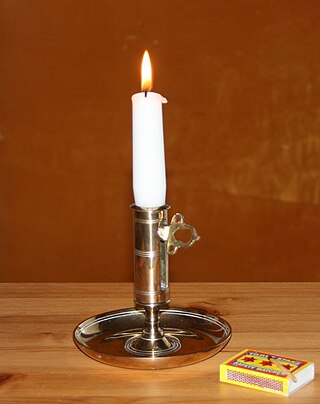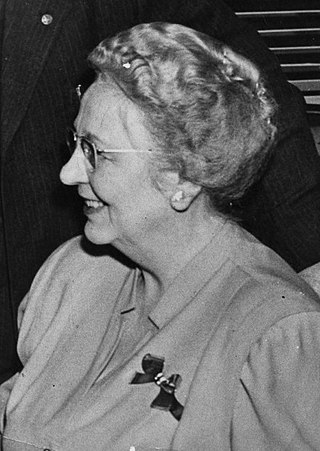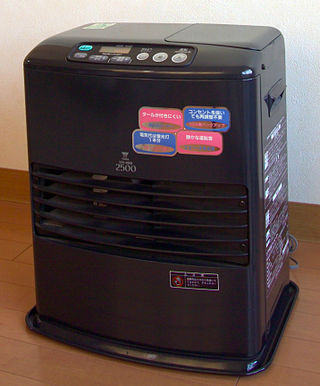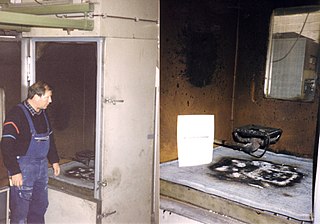Related Research Articles
A Bunsen burner, named after Robert Bunsen, is a kind of ambient air gas burner used as laboratory equipment; it produces a single open gas flame, and is used for heating, sterilization, and combustion.

Fire is the rapid oxidation of a material in the exothermic chemical process of combustion, releasing heat, light, and various reaction products. At a certain point in the combustion reaction, called the ignition point, flames are produced. The flame is the visible portion of the fire. Flames consist primarily of carbon dioxide, water vapor, oxygen and nitrogen. If hot enough, the gases may become ionized to produce plasma. Depending on the substances alight, and any impurities outside, the color of the flame and the fire's intensity will be different.

A candle is an ignitable wick embedded in wax, or another flammable solid substance such as tallow, that provides light, and in some cases, a fragrance. A candle can also provide heat or a method of keeping time. Candles have been used for over two millennia around the world, and were a significant form of indoor lighting until the invention of other types of light sources. Although electric light has largely made candle use nonessential for illumination, candles are still commonly used for functional, symbolic and aesthetic purposes and in specific cultural and religious settings. Various devices can be used to hold candles, such as candlesticks, or candelabras, chandeliers, lanterns and sconces. A person who makes candles is traditionally known as a chandler.
Spontaneous human combustion (SHC) is the pseudoscientific concept of the spontaneous combustion of a living human body without an apparent external source of ignition. In addition to reported cases, descriptions of the alleged phenomenon appear in literature, and both types have been observed to share common characteristics in terms of circumstances and the remains of the victim.

A kerosene lamp is a type of lighting device that uses kerosene as a fuel. Kerosene lamps have a wick or mantle as light source, protected by a glass chimney or globe; lamps may be used on a table, or hand-held lanterns may be used for portable lighting. Like oil lamps, they are useful for lighting without electricity, such as in regions without rural electrification, in electrified areas during power outages, at campsites, and on boats. There are three types of kerosene lamp: flat-wick, central-draft, and mantle lamp. Kerosene lanterns meant for portable use have a flat wick and are made in dead-flame, hot-blast, and cold-blast variants.

A flame is the visible, gaseous part of a fire. It is caused by a highly exothermic chemical reaction taking place in a thin zone. When flames are hot enough to have ionized gaseous components of sufficient density, they are then considered plasma.

Mary Hardy Reeser of St. Petersburg, Florida, was a woman whose fiery death was surrounded by mystery, and even controversially reported at the time to be a case of spontaneous human combustion (SHC). She was often referred to as the "cinder lady" in newspaper accounts of the day.

A Buddy Burner is a simple stove made from a can and part of a corrugated paper box. It is usually fueled by paraffin wax but other fuels, such as boiled butter, animal fat or diesel fuel, can be used. It is usually used for cooking but can also provide heat.
John Irving Bentley was a physician who burned to death at the age of 92 in the bathroom of his house in Coudersport, Pennsylvania. His death was allegedly caused by spontaneous human combustion.
A flash fire is a sudden, intense fire caused by ignition of a mixture of air and a dispersed flammable substance such as a solid, flammable or combustible liquid, or a flammable gas. It is characterized by high temperature, short duration, and a rapidly moving flame front.

A kerosene heater, also known as a paraffin heater, is typically a portable, unvented, kerosene-fueled, space heating device. In Japan and other countries, they are a primary source of home heat. In the United States and Australia, they are a supplemental heat or a source of emergency heat during a power outage. Most kerosene heaters produce between 3.3 and 6.8 kilowatts.
Also known as a "perfume lamp", "effusion lamp," or "catalytic lamp", a fragrance lamp is a lamp that disperses scented alcohol using a catalytic combustion wick consisting of a cotton wick threaded through a natural, porous stone. The catalytic combustion wick was developed and patented by Maurice Berger, a French pharmaceutical dispenser, in 1898 as a means of purifying the air in hospitals and mortuaries. It is claimed that this catalytic oxidation process destroys bacteria in the air and increases oxygen levels.

Spontaneous combustion or spontaneous ignition is a type of combustion which occurs by self-heating, followed by thermal runaway and finally, autoignition. It is distinct from pyrophoricity, in which a compound needs no self-heat to ignite. The correct storage of spontaneously combustible materials is extremely important considering improper storage is the main cause of spontaneous combustion. Materials such as coal, cotton, hay, and oils should be stored at proper temperatures and moisture levels to prevent spontaneous combustion.

A combustible material is a material that can burn in air under certain conditions. A material is flammable if it ignites easily at ambient temperatures. In other words, a combustible material ignites with some effort and a flammable material catches fire immediately on exposure to flame.
Jonas Dupont was a French physician who became famous for the publishing of the book De Incendiis Corporis Humani Spontaneis. Dupont became interested in spontaneous human combustion (SHC) after coming across the Nicole Millet case. This case occurred in 1725, where Nicole Millet's husband was accused of burning her to death, but was acquitted after a surgeon named Nicholas le Cat convinced the court that her cause of death had been SHC. Nicole Millet had supposedly been found burnt to death in an unburnt chair.

The Avondale Mine disaster was a massive fire at the Avondale Colliery near Plymouth Township, Pennsylvania, on September 6, 1869. It caused the death of 110 workers. It started when the wooden lining of the mine shaft caught fire and ignited the coal breaker built directly overhead. The shaft was the only entrance and exit to the mine, and the fire trapped and suffocated 108 of the workers. It was the greatest mine disaster to that point in American history.
Jeanne Lucille Saffin was a British woman whose death from fire in 1982 is cited by paranormal researchers and authors as an example of spontaneous human combustion, and is reported to be the most recent suspected case in the UK. Aspects of the reports made immediately after her injury and death apparently supported the conclusion that her death was due to spontaneous human combustion; John Heymer devoted a chapter of his 1996 book The Entrancing Flame to the case. However, later research has cast doubt on some of the evidence and refutes the claims that her injuries were caused by spontaneous human combustion.

This is an alphabetized glossary of terms pertaining to lighting fires, along with their definitions. Firelighting is the process of starting a fire artificially. Fire was an essential tool in early human cultural development. The ignition of any fire, whether natural or artificial, requires completing the fire triangle, usually by initiating the combustion of a suitably flammable material.

Flameless candles are an electronic alternative to traditional wick candles. They are typically utilized as aesthetic lighting devices and come in a variety of shapes, colors and sizes. A flame-effect lightbulb contains multiple small light-emitting diodes and a control circuit to flash them in a semi-regular, flickering pattern. The bulb may be sold separately with a standard Edison screw for use in ordinary fixtures, or in a self-contained housing with battery.

A Swedish torch is a source of heat and light from a vertically set tree trunk, incised and burning in the middle. Despite its more common name "Swedish torch" it was invented by the Finns and it became known in Europe during the 1600s and is now used by forest workers, and for leisure activities. Due to its flat surface and good embers, it can also be used for cooking. Compared to a campfire, it is more compact, and therefore several small heat sources can be distributed over an area.
References
- ↑ Gee DJ (1965). "A case of 'spontaneous combustion'". Medicine, Science and the Law. 5: 37–8. doi:10.1177/002580246500500108. PMID 14269669. S2CID 25482377.
- ↑ DeHaan JD (1997). "A case of not-so-spontaneous human combustion". Fire & Arson Investigator. 47 (4): 14–6. OCLC 610152071.
- ↑ "New light on human torch mystery". BBC News . 31 August 1998.
- ↑ Palmiere C, Staub C, La Harpe R, Mangin P (2009). "Ignition of a human body by a modest external source: a case report". Forensic Science International. 188 (1–3): e17–9. doi:10.1016/j.forsciint.2009.03.027. PMID 19410396.
- ↑ "Coroner rules Irish man died of spontaneous combustion". Yahoo News . 23 September 2011.
- ↑ "BBC News – 'First Irish case' of death by spontaneous combustion". BBC. 23 September 2011. Retrieved 23 September 2011.
- 1 2 "Galway City Tribune – Galway pensioner died from spontaneous combustion". galwaynews.ie. 23 September 2011. Archived from the original on 24 September 2011. Retrieved 23 September 2011.
- ↑ Ensor, Josie (23 September 2011). "Irish pensioner 'died of spontaneous human combustion'". The Telegraph. Retrieved 23 September 2011.
- ↑ "'First Irish case' of death by spontaneous combustion". BBC. 23 September 2011. Retrieved 25 September 2011.
- ↑ "Irishman died of spontaneous human combustion, coroner claims". MSNBC. 26 September 2011. Archived from the original on 27 September 2011. Retrieved 8 October 2011.